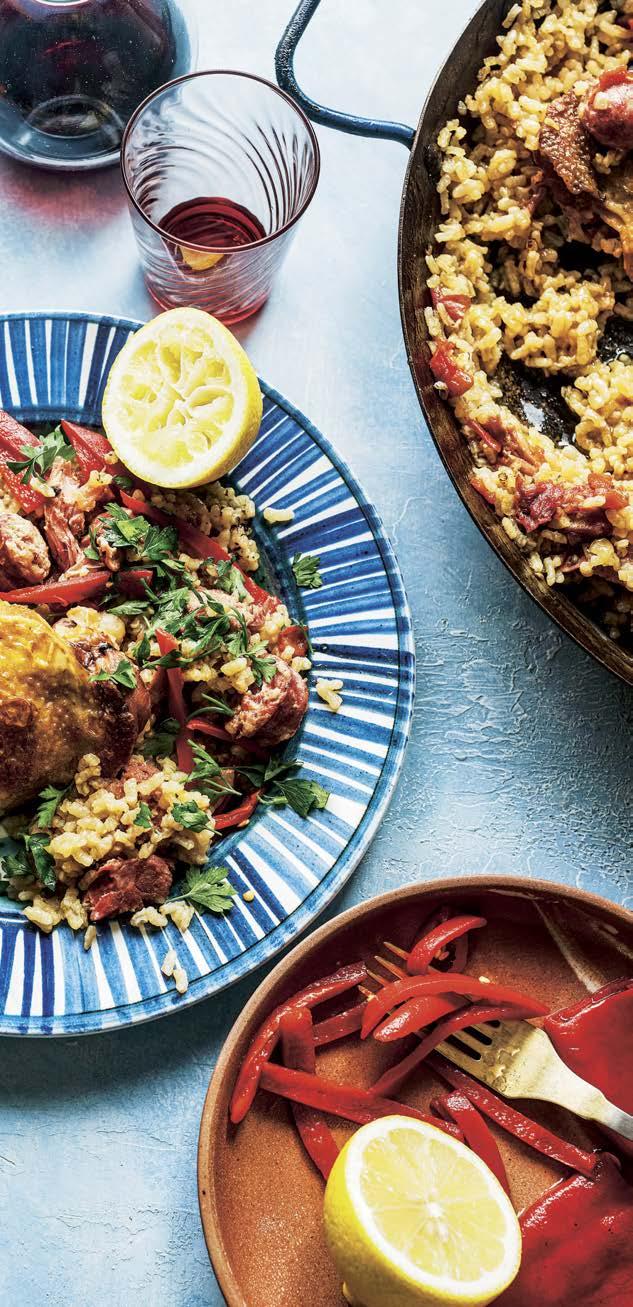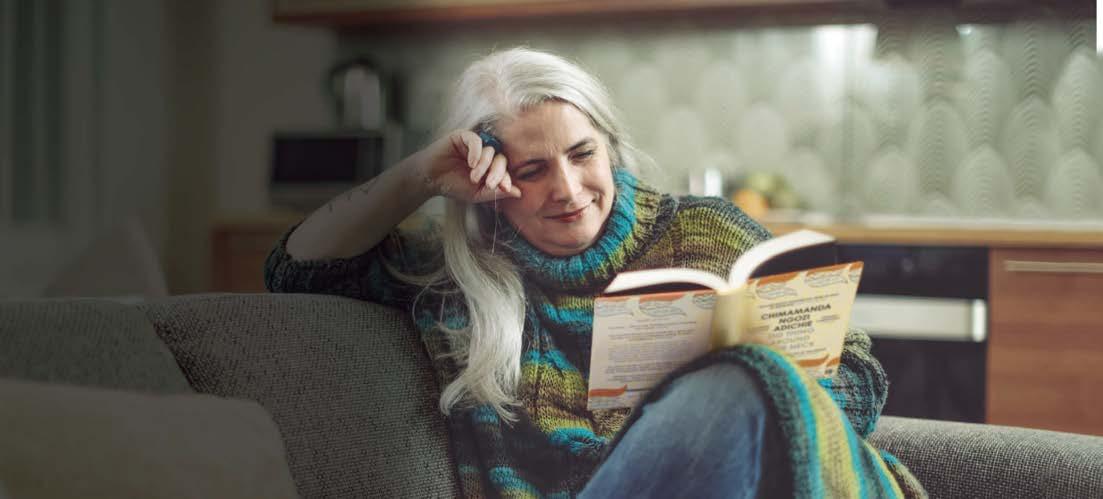
11 minute read
Eat in
The dream team
Diana salutes chicken and rice, a classic combination that unlocks a world of easy and adaptable dinners
Advertisement
THE STAPLE I GREW UP WITH wasn’t rice, but potatoes. There was a big jar of basmati, but it was used as a percussion instrument when my siblings and I put on concerts (it accompanied our rendition of Little Donkey every Christmas). We didn’t eat rice until my mum got into what was then thought of as glamorous foreign food –goulash and chilli and Madhur Jaffrey’s Mughlai chicken – and we cooked it badly. I don’t know where this approach came from, but we drained the cooked rice in a sieve, then ran cold water through it, followed by boiling water. This was done very carefully so we actually ended up with a bowl of rice that had separate little grains. But we were better at potatoes.
Now there are eight bags of different types of rice in my cupboard: jasmine rice, basmati, several kinds of risotto rice (carnaroli, vialone nano and arbo-
rio all produce different results) and a couple of kinds of paella rice. The rice used for paella, and other Spanish rice dishes, is a marvel. It must not be stirred. You just leave it to drink in the stock and other flavours around it, until you have grains swollen with umami.
There are 40,000 varieties of rice, categorised in different ways: by fragrance, where it’s grown – under water or on hillsides, for example – texture (sticky or not), grain size and shape.
‘Chicken and rice’, like ‘tea and toast’, rolls off the tongue, as if the two were meant to be together. All over the globe, they’re joined – it’s an elemental combination. Neither chicken nor rice is strongly flavoured, so the cook can take these basics and dress them up. If you google ‘chicken and rice’, your head will spin. You could make a different dish every day of the year: Turkish chicken and rice pilaf with dill, chicken and sausage jambalaya, chicken biryani, arroz con pollo (I must have cooked this a thousand times). There are Iranian baked rice and chicken dishes, which are more complicated and can contain yogurt. They’re turned out so the tah dig, the crusty rice from the bottom of the pan (much prized), can be seen.
The most useful chicken and rice dishes to know about, because they’re so adaptable, are pilafs, where the rice is cooked by the absorption method (as in the recipe on p43), Spanish rice dishes, which don’t need much attention, and fried rice dishes (if you can make egg and chicken fried rice, you’ll never throw out leftover rice again). I also put chicken – just the shreds from a leftover roast – in risottos to make another meal out of not very much.
Then there are baked chicken and rice dishes. I make a huge range of these with very different flavours, an approach I started when I had my first child. This is good ‘cooking in exhaustion’ food as it all goes into the oven. You must stick to specific measurements but can alter the character of the dish at will. Use a 30cm-wide shallow casserole, 175g basmati rice (washed in a sieve until the water runs clear) and 550ml boiling stock. Sauté onion and garlic before adding the rice, and anything else you fancy – aubergine, pumpkin or mushrooms – plus spices and flavourings. Try something as simple as pumpkin, ginger and chilli, then add the rice and stock. Put bone-in chicken thighs – they can be browned or, if you’re in a hurry, left raw (season them with sea salt to make the skin crunchy) – on top and bake at 180C fan for 40-45 minutes. The chicken will be golden, the stock absorbed and the rice tender. It’s a great blueprint recipe. A couple of days later you can make something completely different using the same basic components. If you have chicken and rice, good eating is never far away.
Key to dietary information
If you can’t get butifarra sausage, use spicy Italian sausages or, failing that, any good-quality spicy sausage
DF GF Arroz a la catalana
Serves 6 Cooking time: 1 hour 15 minutes A Spanish rice dish from Catalonia. There, it also includes pork ribs and can be made with rabbit instead of chicken. The great thing about Spanish rice dishes is that you shouldn’t stir them, so this is hands-off once you’ve done the initial browning. When the rice is added, you stick the dish in the oven, where the rice just sucks up the stock and goes gorgeously brown on top.
Ingredients
6 large chicken thighs, bone in and skin on 2 tbsp olive oil 435g butifarra sausage, cut into chunks 200g thick-cut ham or ham from a hock, either chopped or torn 1 large onion, finely chopped 4 garlic cloves, finely chopped 2 plum tomatoes, chopped 1.2 litres chicken stock 325g paella rice 230g jar of pimiento piquillo peppers, drained 3 tbsp roughly chopped parsley Juice of 1/2 lemon
Method
Trim any straggly bits of chicken skin from the thighs and heat the olive oil in a shallow casserole, about 35cm across. Brown the chicken all over –you’re just getting colour, not cooking it through – and season it. As the chicken is cooked, transfer it to a bowl. Add the sausage to the pan and brown it all over too, then add the ham and cook it for another minute. Lift these into the bowl containing the chicken. There will be enough oil left in the pan for the onions – if there’s a lot of oil, pour the excess out until you have 2 tbsp in the pan. Fry the onion until it’s soft and golden, then add the garlic and the tomatoes and continue to cook until the tomatoes are thick and pulpy. Add the stock and put the chicken, sausage and ham back in the pan, together with any juices that have come out of the meat. Bring to just under the boil, then turn the heat down low and cook, covered, for 15 minutes. Heat the oven to 180C/170C fan/gas mark 4. Add the rice, pouring it in around the chicken. Season. Stir a little to make sure the rice is under the stock, but don’t stir it after that. Transfer the dish to the oven and cook it for another 20 minutes, uncovered. In this time, the rice will absorb the stock and become tender. If it’s still a little wet, or the rice isn’t tender, put it back in for another 5 minutes then check again. Cut the peppers into strips and strew them over the top. Scatter on the parsley then squeeze on the lemon juice and serve.
Photography HAARALA HAMILTON

Cook the rice in advance, then spread thinly over a baking sheet to cool it down quickly

Chicken and egg fried rice
Serves 4 Cooking time: 30 minutes, plus 20 minutes for the rice in advance Woks in our home kitchens never get as hot as they do in restaurants, where they have a lot of power under them – so dishes like this won’t be as perfect as they could be. Unless you’ve grown up stir-frying, it’s hard to get it right too. All those different elements cooked in one pan? You have to think about how much time each one needs. Nevertheless, I have, over the years, managed to do chicken and egg fried rice in a way that works, at least for the family on a weeknight. I cook the dish in stages and do the eggs in a separate pan, otherwise I end up with rice and scrambled eggs. I don’t even think about making this with freshly cooked rice (it will just get sticky). I use Chinese chilli bean paste in other dishes too, so don’t feel buying it is a waste of money. The alcohol is my own thing (goodness knows what Ken Hom would think) but I love its flavour with ginger. You can leave it out if you don’t fancy it.
Ingredients
31/2 tbsp groundnut oil 300g chestnut mushrooms, sliced 3 shallots, chopped 4 garlic cloves, finely chopped 3cm piece ginger root, peeled and grated 4 spring onions, trimmed and chopped 175g Savoy cabbage or white cabbage, hard core removed and the leaves cut into narrow slices 300g chicken thigh fillets, cut into bite-sized pieces 250g pak choi, washed and sliced lengthways 4 large eggs 2 tsp sesame oil 600g cold cooked rice 1 tbsp Chinese chilli bean sauce or paste 5 tbsp Shaoxing wine or dry sherry (optional) Soy sauce and chilli oil or chilli sauce, to serve (optional)
Method
Heat 1 tbsp of oil in a wok. When it’s really hot, add the mushrooms and fry briskly to get a good colour. Season. The mushrooms will exude water, so make sure this has evaporated off. Remove from the pan into a bowl. In the same wok, heat 11/2 tbsp of oil and toss in the shallots, garlic, ginger, the white bits of the spring onions and the cabbage. Stir-fry for a minute, keeping things moving, and add the chicken. You want to get a good colour on it. Season and stir-fry for 2 minutes, add the pak choi and cook for a further minute. Add everything in the wok to the mushrooms. Mix the eggs with salt and the sesame oil. Heat half of the remaining oil in a small pan and cook the eggs as you might an omelette, tilting the pan and pushing the cooked egg away from you to let the uncooked egg flow into the hot pan. Use chopsticks to break the egg into ribbons. Put the remaining oil into the wok and heat till very hot. Toss in the rice and stir-fry for 3 minutes or until you can see and smell some of the rice toasting. Season, then add the cooked ingredients, the egg and the chilli paste. Add the wine or sherry, if using, and toss the mixture around. Serve with the green bits of the spring onions on top, and soy sauce, chilli oil or chilli sauce on the side, if you like.


G
Chicken, cardamom, carrot and orange pilaf
Serves 4 Prep time: 10 minutes Cooking time: 1 hour This Middle Eastern dish is scented, a little sweet and very pretty. In the original, the orange zest, cooked in sugar syrup, ends up a lot sweeter. I’ve toned it down, partly for ease, partly for health reasons. It’s still a gorgeous dish. It can be made grander with saffron butter. Soak a pinch of saffron strands in 11/2 tbsp boiling water for 20 minutes, melt some butter and add the saffron water. Pour this on before serving. If you can get on top of making pilafs, you can do them with lots of different ingredients. I often make them with what I have – the remains of a roast leg of lamb, toasted almonds and dried sour cherries, for example – so I’m always stocked up with long-grain rice and dried fruit and nuts.
Ingredients
300g basmati rice 1 orange 1 tbsp olive oil 600g chicken thigh meat, cut into bite-sized pieces 1 tsp coriander seeds 7 cardamom pods 40g butter 1 onion, finely chopped 4 garlic cloves, finely chopped 900ml chicken stock 125g carrots, peeled and cut into matchsticks 1 tbsp granulated sugar 25g unsalted pistachios or blanched almonds, chopped 4 tbsp chopped coriander
Method
Put the rice into a sieve and rinse it under the tap until the water runs clear. Cut the rind off half the orange with a very sharp knife or potato peeler, trying to remove it in broad strips. Slice away as much of the white pith as possible and cut the rind into fine strips.
Some pilaf recipes suggest soaking the rice in water, but if you’re making this last minute, just wash it in a sieve
Squeeze the juice from the orange into a bowl. Heat the olive oil in a frying pan and quickly brown the chicken pieces over a high heat to get a good colour (you are only colouring the meat, not cooking it through). Remove to a bowl. Crush the coriander seeds in a mortar and pestle and put into a small bowl. Crush the cardamom so that you can remove the pods (discard them), then crush the seeds. Heat half of the butter in a heavy-bottomed pan and sauté the onion until pale gold. Add the garlic and cook for a couple more minutes, then add the spices and cook for another minute. Add the rice and stir until it’s well coated in butter and just beginning to toast. Add the stock and the orange juice and bring to the boil. When the surface starts to look pitted, turn the heat right down. Tumble in the browned chicken and cover the pan. The rice will cook in the steam. Don’t stir or you’ll release the starch and the rice will become sticky. It will take about 15 minutes to cook. Meanwhile, melt the rest of the butter in a pan and sauté the carrots over a medium heat until softened (they need to lose their raw bite). Remove the carrots and put the orange rind into the buttery juices. Cook for a couple of minutes over a medium heat until softening, then add the sugar and stir until all moisture is cooked off and the zest is slightly caramelised. Gently fork the carrots and the rind into the cooked rice, along with the nuts and coriander. Serve immediately.

For thousands of recipe ideas, go to telegraph.co.uk/ cookbook










